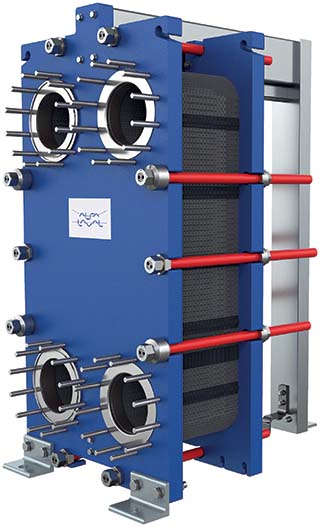A cooler dairy with natural refrigerants
Designing an energy efficient logistics center for a dairy plant in Greece using an Alfa Laval ammonia evaporator system.
DATE 2023-11-28To minimize the global warming potential (GWP) of heating and cooling applications many businesses today turn to using natural refrigerants. This was also the case when a small family enterprise in Greece expanded into an environmentally and socially conscious, rapidly growing dairy industry with a new logistics center using Alfa Laval products with natural refrigerants.
Naturally delicious with a sustainable approach
L.A. Farm S.A. began as a small family enterprise. It is known for its delicious, genuine Feta cheese, made with milk from the family’s sheep and goats, and those of their fellow villagers. Today, it is a rapidly growing dairy industry based in Thessaly, in the north of Greece. Since its establishment, it consistently produces excellent dairy products, using the best and purest ingredients as well as contributing to the progress and well-being of the local community with safety and environmental awareness as key considerations.
When it was time to invest in a new 14,000m2 refrigerated logistics center, energy efficiency and low environmental impact were high on the agenda. How could a system become safe, energy efficient, and respect both the local, and global environment?
To achieve as much energy savings as possible, as well as being sustainable, EcoRef Engineering Consultants, specialized in energy saving studies for refrigeration installations, backed up by AT&C Agencies, the local Alfa Laval Representative, and the Refrigeration Contractor company Cool Dynamic, designed and installed a low charge ammonia refrigeration system that met all the requirements.
Ammonia has a Global Warming Potential (GWP) of zero. It is also one of the most efficient refrigerants available. So apart from being a natural refrigerant, the use of ammonia creates opportunities to reduce energy consumption and secure long-term cost efficiency and sustainability.
Sustainable secondary cooling system for increased safety
To increase safety, there is a growing trend to design systems that reduce the ammonia charge by applying a secondary cooling operation. This means connecting the system via liquid evaporators to a secondary heat transfer fluid circuit, on the cold side. In the case of L.A. Farm S.A., Temper -15 is used as secondary fluid, cooled from return temperature of -3 °C down to a supply of -7 °C instead of ammonia circulating the cold storage plant.
High efficiency and further reduced ammonia refrigerant charge
In accordance with the dairy cooling need, including 100% redundancy and high efficiency demand, Alfa Laval proposed two compact flooded ammonia evaporators each consisting of an Alfa Laval TK20 semi-welded plate heat exchanger equipped with a U-Turn plug-and- play liquid separator. Each with the ability to supply the system capacity need of 1,400 kW cooling with a very low charge of ammonia.
The lower charge is due to the installed U-Turn gravity separator module that in addition to conventional gravitational separation, utilizes agglomeration, surface tension and centrifugal forces to improve the separation function. This in combination with a low pressure drop - up to four times lower than in a conventional separation system - becomes more energy efficient and further reduces the required refrigerant charge.
In total, the higher energy efficiency compared with a conventional system saves some 340 MWh/year and reduces the indirect CO2 emission of appr. 300 ton/year.
The solution adopted in the refrigeration plant is a perfect example of solutions that will be followed in the near future. Low charge ultra-efficient ammonia system (compact flooded) that follows the load of the plant proportionally. The system provides very high COPs, and energy consumption that exceeds expectation especially in partial loads and medium ambient temperatures.” - Daniel Pappas, Managing Partner at ECOREF (Refrigeration Consultants & Designers)
Great energy savings and reduced ammonia charge
John Gregoriadis, Managing Director at AT&C Agencies, states that “the final plant design resulted in a total ammonia charge for the plant of only 680 kg including the externally placed evaporative condensers, that hold 200 kg each. In addition to the compact design and low ammonia charge of less than 0.3 kg per kW, the Alfa Laval semi-welded plate heat exchanger allows for a close refrigerant approach which makes it possible to save energy. This could be done with a very satisfactory total refrigeration COP of 3.9 for the plant.”
The overall improved efficiency of the cooling system resulted in a greatly reduced energy consumption for the customer. The design of the U-Turn and plate heat exchangers with its extremely low refrigerant charge also resulted in a very reliable system even in partial loads with a minimum environmental impact.

Major equipment in the plant
- 2 Alfa Laval TK20-BW semi welded plate
heat exchangers of 1,400 kW, equipped
with U-turn ammonia evaporation gravity
separator module - Defrost function with an Alfa Laval AlfaNova
fusion bonded heat exchanger using ammonia
discharge energy - 4 Sabroe compressors with inverter motor
producing 390 kW each at 1,800 rpm - 2 Mita Axial Evaporative condensers
- Temper technology’s Temper-15 heat
transfer fluid

